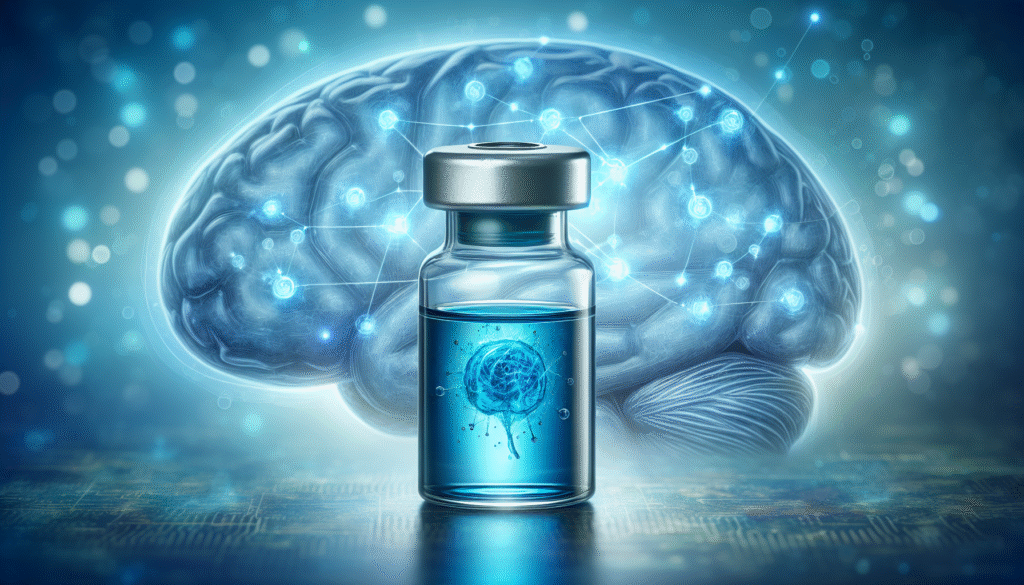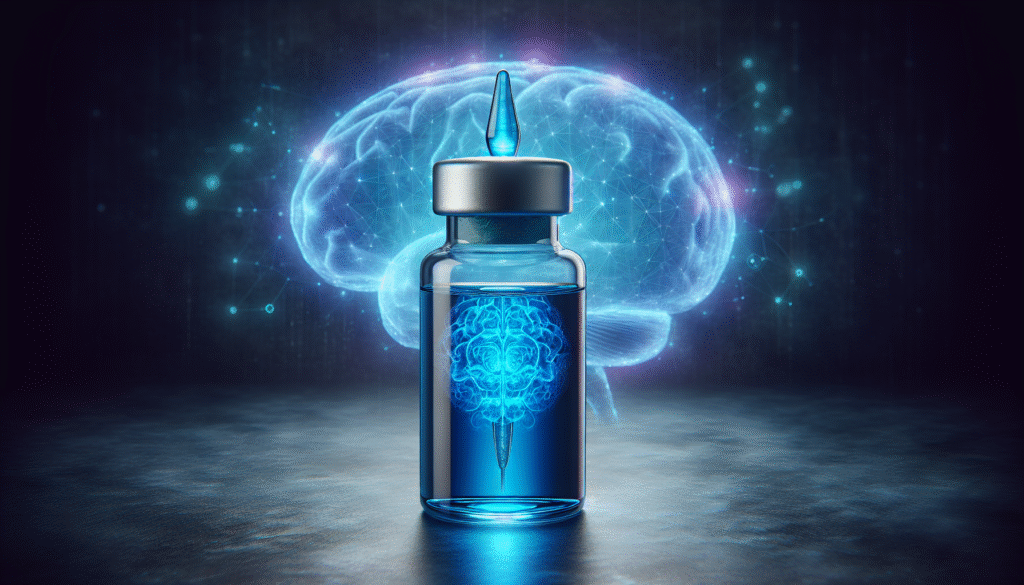
Have you ever wondered how certain compounds influence your brain’s metabolism and energy levels?

Methylene Blue: An Overview
Methylene Blue (MB) has existed for over a century, primarily known as a dye and antiseptic. However, recent scientific explorations have revealed its significant potential in enhancing brain metabolism and energy levels. As you navigate through this article, we will unpack the layers of how Methylene Blue interacts with your brain’s cellular mechanisms.
The Chemical Structure of Methylene Blue
Methylene Blue is characterized by its iconic chemical structure, consisting of a phenothiazine derivative. It has a molecular formula of C16H18N3SCl and appears as a blue crystalline powder. Understanding its chemical composition is crucial as it plays a significant role in its function within biological systems.
Historical Context
Initially synthesized in the late 19th century, Methylene Blue served multiple purposes, from being an antimalarial agent to treating methemoglobinemia. However, its neurological effects began emerging in the research landscape more recently. Investigations have highlighted its possible neuroprotective properties and metabolic enhancing capabilities.
Mechanism of Action: How Methylene Blue Supports Brain Function
Understanding the mechanism of action of Methylene Blue is imperative for grasping its effects on brain metabolism. Within the brain, this compound influences a myriad of biological processes.
Electron Transport and Cellular Respiration
Methylene Blue acts as an electron carrier in the mitochondrial electron transport chain. By facilitating the transfer of electrons, it enhances the rate of ATP (adenosine triphosphate) production. ATP is often termed the “energy currency” of the cell, powering various cellular functions and processes.
Enhancing Mitochondrial Efficiency
The mitochondria, often referred to as the powerhouse of cells, are central to energy production. Methylene Blue does not merely provide energy; it amplifies the efficiency of energy generation within mitochondria. By improving mitochondrial function, your brain can become more resilient to stress and other factors that could impair its performance.
Table 1: Effects of Methylene Blue on Mitochondria
| Key Function | Effect of Methylene Blue |
|---|---|
| Electron Transport | Enhances electron flow |
| ATP Production | Increases ATP synthesis |
| Oxidative Stress Resistance | Reduces oxidative damage |
| Metabolic Rate | Boosts overall metabolic activity |
Neuroprotective Properties
Methylene Blue has exhibited neuroprotective properties, making it a fascinating compound in the field of neuroscience. These protective effects may result from its ability to reduce oxidative stress and inflammation within brain cells.
Reducing Oxidative Stress
Oxidative stress results from an imbalance between reactive oxygen species (ROS) and antioxidants in the body. Methylene Blue acts as an antioxidant, mitigating oxidative damage. This attribute is particularly crucial for neurons as they are highly vulnerable to oxidative stress.
Influencing Neurotransmitter Systems
In addition to its metabolic effects, Methylene Blue also interacts with neurotransmitter systems, specifically by influencing serotonin and dopamine levels in the brain. Serotonin, often referred to as the “feel-good” neurotransmitter, plays a significant role in mood regulation. Conversely, dopamine is associated with motivation and pleasure.
Energy Levels and Cognitive Performance
As you think about the relationship between energy levels and cognitive performance, Methylene Blue emerges as a powerful ally.
Boosting Cognitive Function
The increased energy production can have a direct correlation with your cognitive abilities. Enhanced ATP synthesis translates into improved mental clarity, focus, and cognitive speed. Scientific studies suggest that Methylene Blue can help sharpen memory retention and recall.
Clinical Evidence
Numerous studies have investigated the cognitive-enhancing effects of Methylene Blue on both healthy individuals and those suffering from neurological disorders.
Table 2: Clinical Studies and Findings
| Study | Population | Findings |
|---|---|---|
| Phase 2 Clinical Trial | Alzheimer’s Patients | Significant improvements in cognition |
| Pilot Study | Healthy Adults | Enhanced memory and attention |
| Animal Study | Mice | Improved learning and memory functions |
Dosage and Administration of Methylene Blue
Understanding the appropriate dosage and methods of administration is pivotal for leveraging the benefits of Methylene Blue while minimizing potential side effects.
Recommended Dosage
The optimal dosage for Methylene Blue can vary based on individual factors such as age, weight, and specific health conditions. While some studies suggest that doses between 0.5 to 4 mg/kg can yield cognitive benefits, it is essential to consult with a healthcare provider before starting any supplement regimen.
Forms of Methylene Blue Available
Methylene Blue can be administered in several forms, including:
- Oral tablets
- Injectable solutions
- Intravenous formulations
Choose the form that best suits your needs and aligns with your healthcare provider’s recommendations.

Side Effects and Considerations
As with any compound, Methylene Blue is not without its side effects and considerations.
Common Side Effects
Some individuals may experience side effects such as:
- Headaches
- Nausea
- Anxiety
- A temporary blue discoloration of urine
These side effects are generally mild and may diminish over time as the body adjusts to the compound.
Contraindications
It is crucial to be aware of contraindications. Methylene Blue is not recommended for individuals with certain conditions, such as:
- G6PD deficiency
- Severe kidney disease
- Pregnancy (unless specifically approved by a healthcare provider)
Consultation with a healthcare professional is essential to assess your individual risks before incorporating Methylene Blue into your regimen.
The Future of Methylene Blue Research
The promising findings regarding Methylene Blue have catalyzed a surge in research efforts aimed at understanding its broader implications. Scientific investigations continue to explore its potential applications in various neurological conditions, including:
Neurodegenerative Diseases
As researchers delve deeper into Methylene Blue’s effects, its potential role in managing or even preventing neurodegenerative diseases like Alzheimer’s and Parkinson’s is particularly intriguing. Research indicates that Methylene Blue may improve mitochondrial function and reduce neurodegeneration.
Mood Disorders
Given its influence over serotonin levels, Methylene Blue shows promise in potentially treating mood disorders such as depression and anxiety. Clinical trials are evaluating its efficacy as a novel treatment approach in mental health.

Incorporating Methylene Blue into Your Lifestyle
If you’re considering integrating Methylene Blue into your lifestyle, it is essential to approach it thoughtfully and responsibly.
Consultation with Healthcare Providers
Before making any changes to your health regimen, engage with a healthcare professional who understands your history and current health status. They can provide tailored advice and monitoring, ensuring that your use of Methylene Blue is both safe and effective.
Tracking Personal Response
Once you’ve received clearance to use Methylene Blue, consider keeping a journal to track your experiences, including changes in energy levels, cognitive functions, and any side effects. This data can be invaluable for both you and your healthcare provider.
Concluding Thoughts
In your pursuit of enhanced brain metabolism and energy levels, Methylene Blue has emerged as a noteworthy compound with an array of benefits. By functioning as a mitochondrial enhancer, antioxidant, and neurotransmitter modulator, it holds the potential to bolster cognitive function and overall brain health.
As research progresses, the implications of Methylene Blue could extend beyond mere energy enhancement, offering promising avenues for the treatment and management of neurological and mood disorders. However, careful consideration, consultation with health professionals, and personal monitoring are essential as you embark on this journey.
By understanding the nuances of Methylene Blue, you empower yourself to make informed decisions regarding your cognitive health and energy management. The brain’s capacity for improvement is profound, and Methylene Blue could be one of the many tools you utilize to unlock your full potential.
